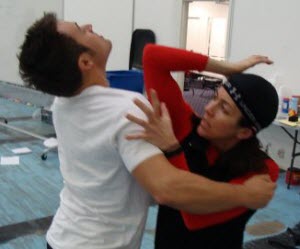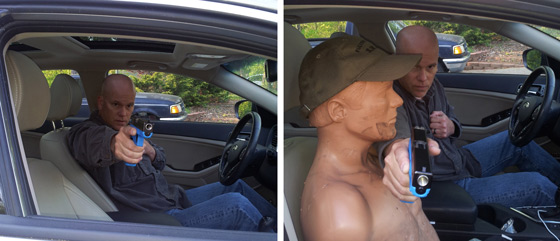 At the core of self defense is this basic concept: Get Out If You Can. It really is as simple as that. There are no bonus points for beating up the bad guy. There is no special award for meeting the police with the attacker on the ground next to you. The only reward in a violent attack is the ability to survive and continue to live a life afterward. Learning to strike effectively and efficiently can be one of the most powerful skills for an individual to possess in the event they encounter a life-threatening situation.
At the core of self defense is this basic concept: Get Out If You Can. It really is as simple as that. There are no bonus points for beating up the bad guy. There is no special award for meeting the police with the attacker on the ground next to you. The only reward in a violent attack is the ability to survive and continue to live a life afterward. Learning to strike effectively and efficiently can be one of the most powerful skills for an individual to possess in the event they encounter a life-threatening situation.
Striking techniques need to be easy enough that someone can retrieve them under intense stress. I recently had a client who had experienced a random violent attack. Her situation was innocent enough: As she was leaving church after attending a Christmas Eve service, she was confronted by a man who struck her and knocked her down. As she tells it, it happened so fast that by the time she realized what was going on, the attack was already in motion and she was lying on the ground. In her situation, fortunately, she was able to utilize a few functional strategies to get the man off her and, short of the emotional trauma, was able to walk away from the encounter unscathed. What did she do? She kept it simple.
When instructors teach complicated leverage skills or step-by-step movements to students who have little experience in unarmed defense, they are providing them with responses that will be useless in an unexpected violent encounter. Why? Those who have limited experience with unarmed striking techniques will not be able to retrieve the information under stress. When they are anxious and panicking, the only response they will be able to retrieve from their memory “files” will be those that utilize major motor skills.
How can someone build those “files”? By learning four concepts of striking: Targets, Weapons, Centerline and Power Source (TWCP).
T: Vital Target Areas
A violent attack is often unexpected (an ambush) and extremely fluid. Despite any previous training that the victim may have had, there is most certainly going to be a brief moment of shock that results in a very slow, or nonexistent, response to the threat. This happens, as it did for my client, when the brain attempts to catch up to the “real time” situation. That process could take less than a second, or it could take minutes. When the victim is able to re-engage and begin to defend themselves, their main objective is to get away. Anyone who has been involved in an attack or has been dedicated to training with realistic scenarios can testify that an attack can be in any number of unpredictable stages, situations or environments when they are finally able to re-engage and defend.
In the best-case scenario, they will quickly be able to find a small window of opportunity to strike at the threat in an effort to distract or disable them. Striking under stress and while in motion, however, needs to be experienced in a training environment. If someone has not experienced their awareness of vital striking areas, that moment of intensity will be the most dangerous time to “try it out.” As simple as it seems, the mere process of slowly moving from one striking area to another while training may be enough to capture that image and recover it under stress.

Using your hard elbow against the soft parts of your attacker’s throat and head is a fundamental and effective close-quarters defensive strike.
What are the vital areas to consider?
Throat: The most deadly striking target on the body. It can be amusing to watch as defense instructors demonstrate intricate methods of striking the throat. It really is pretty straightforward. A forceful strike to the throat will collapse the airway and consequently end the attack.
Eyes: While not a physically disabling tactic, there is no question that an attacker will be distracted by a counterstrike to the eyes. This instant of “startle” may be just enough to provide the victim with a few seconds to escape the encounter and save their life.
Soft Tissue: Don’t underestimate the “softer” areas to be attacked in a close quarters situation. The fingers, flesh, ears, and nose are all very sensitive areas that, while not potentially disabling, can be distracting enough to allow the victim an opportunity to get away from the threat.
W: Know Your Weapons
Individuals skilled in defensive shooting techniques spend a large portion of their training becoming acquainted with their weapons. They know the performance and maintenance records of the guns that they use. They train with them often, simulating possible scenarios they might encounter. Learning to be proficient in unarmed defense is no different. Individuals need to know which weapons are the most effective to utilize in threatening situations and then train with those “weapons” in mock scenarios.

Practice your striking for use in close-quarters defensive situations, not wide-open training environments.
Keeping that in mind, individuals need to train for the worst-case scenario. They should train as though the attacker is on top of them. When there is very little space to maneuver, the ability to utilize traditional martial arts techniques will be minimal. In most cases involving a close quarters encounter, punching and kicking are impractical. The weapons to focus on are those that can be utilized in a tight situation that is both mobile and unpredictable.
Close Quarter Weapons in High Threat Situations
- Elbow
- Knees
- Fingertips
- Teeth
- Head
- The rule of thumb in a violent situation is simple.
Use the closest vital weapon you have to hit the closest vital target you see.
C and P: Understand Your Centerline and Power Source
When confronted with something unexpected and frightening, the human response is to get away from the threat. That “fight or flight” mechanism is instinctually wired into us to help us survive even the most dangerous situations. “Flight” is self-explanatory. Above all else, if the opportunity presents itself … get out! “Fight,” as we have been discussing, is more subjective, as it is defined by the victim’s training experience.
When working on strikes in scenario-based environments, here are a few skill sets to keep in mind for maximum retention.
Understand Your Centerline.
The quickest path from the weapon to the target is a straight line. Imagine a line that radiates directly from the center of your body forward. This centerline is the “sight” of a strike. Line the centerline up to the target area and then execute the strike. Fingertips and palm strikes are excellent examples of movements that utilize a direct centerline concept.
Understand Your Power Source.
Unfortunately, many people believe that power comes from the shoulders and arms. While having a solid structure is helpful in any type of physical encounter, arms and shoulders are not solely responsible for generating strength and follow-through. Power originates from the hip base. When striking with either a centerline technique or a circular skill (e.g., elbow and knee strikes), it is critical to understand that the core of the body is responsible for generating the follow-through and power that are necessary to be devastating. Proper rotation of the body while striking is crucial to the effectiveness of the strike.
Cover and Protect.
Regardless of where you are: on your feet, on the ground, or being tossed about, keep your hands up on your centerline. Protect YOUR vital target areas such as your airway and eyes. If nothing else, keeping your hands in front of your body will allow your fingers and elbows to be used as weapons. Understanding target areas, proper weapons and the basics of the centerline and power source are important steps in helping to survive an unexpected threat. Remember, however, that reading about these concepts won’t make you any safer until you practice them. Written information is great, but it will never be a substitute for real training. Find a training partner dedicated to developing their unarmed defensive skills, and jump on the mat to put these concepts into action!

EXCELLENT ARTICLE!!!! While many people are life-long students of combative martial arts, some others are not. Not everybody has the time, energy, money, to devote hours in a dojo. Thank you for provide PRACTICAL, USEFUL, NO NON-SENSE information.
Great article!
Very good article. So much of what is taught as self defense consists of a complicated set of moves that will be forgotten by the student before they get into their car to head home from the class.
Thank you
Thanks.
Thank you Kelly, I found your article very interesting, relevant, succinct and coming from a great knowledge and experience. I'm in the field of Christian ministry and have utilized my martial arts background to help others. I find your article very helpful and inspiring and so I just wanted to encourage you. Gratefully, Jonathan
Hi Matt! I appreciate your response and your input. You are correct, I am a certified PDR instructor and a huge fan of many of Tony Blauer’s training philosophies and proud to be a fellow contributor to PDN right here with him. One of the great components of Tony’s PDR program is that it allows someone with a limited background in defensive tactics to quickly ascertain effective skills that can safe their life in a violent encounter. After 25+ years of Martial Arts training, it is that fact that made me want to become PDR Certified. Of course, basic defensive skills such as target areas, striking points and centerline are universal concepts. PDR training mirrored some of the best parts of the years of martial art training that I’ve experienced and conducted. Just as Tony doesn’t give credit to the first person that taught him an elbow strike when he teaches PDR, it would be disingenuous of me to reference PDR every time I write about self defense. As Tony himself says, he didn’t “invent†the flinch or the fact that people get startled. If I were giving credit to all of the incredible instructors who have influenced my teaching and training for over 30 years, it would be a very long list of individuals. With that being said, if I were to write about concepts and/or use terms that are exclusive to PDR or SPEAR, (such as Converting the Flinch, “Outside 90†or the S.P.E.A.R.) I would most certainly acknowledge the origins of the (great) material. Again, thanks for checking out the article! Kelly
Kelly, Good stuff. Since you are a certified PDR instructor and are obviously referencing points you no doubt learned from PDR/Tony Blauer, why not at least make some reference to such? Respectfully, Matt
Thanks Roy! I am glad you found it helpful. Keep watching for more articles! Being able to do a little "damage" is a great thing if it's going to help keep you safe.
Good article! I hope I never have to use any of those skills, because I'm an old geezer, but if some creep attacks me, maybe I can do a little damage.